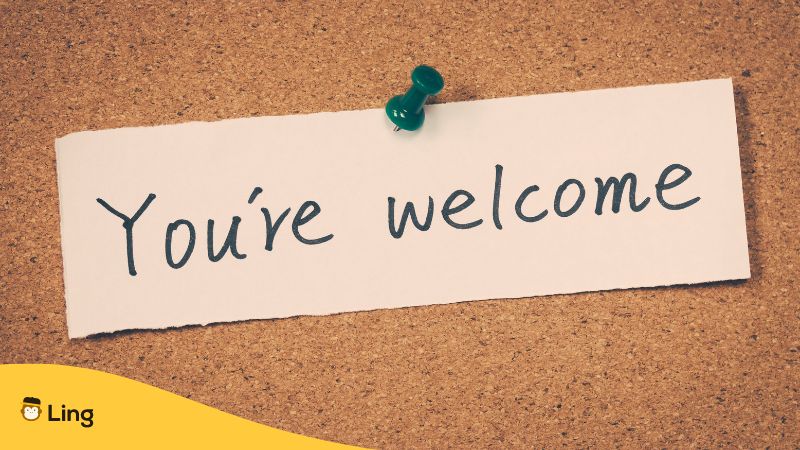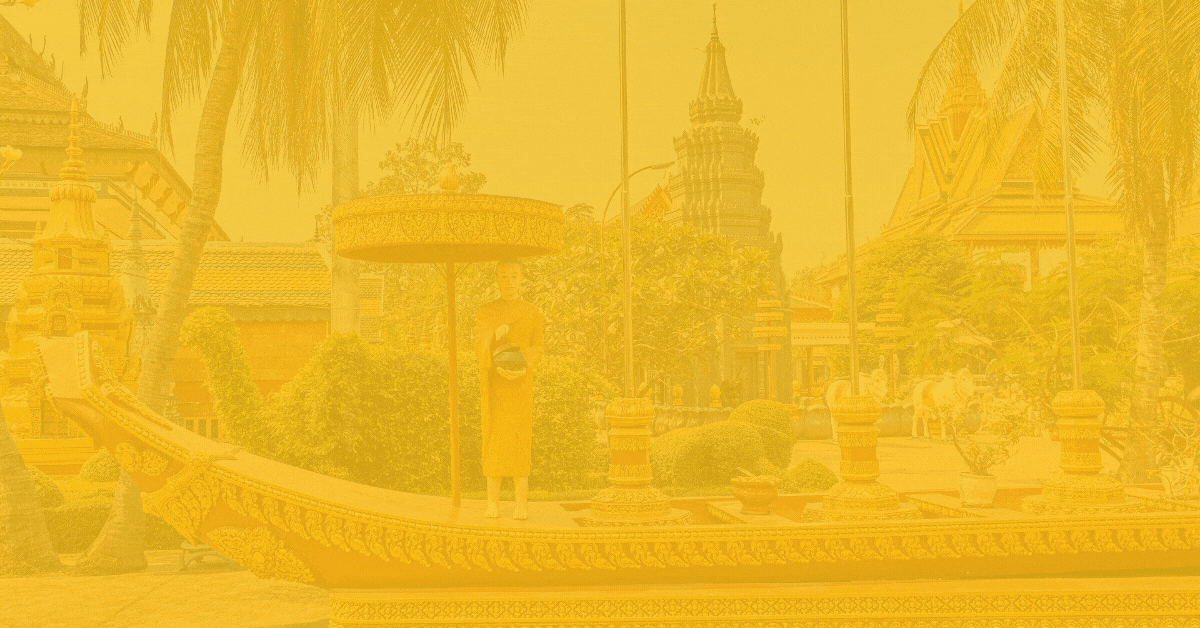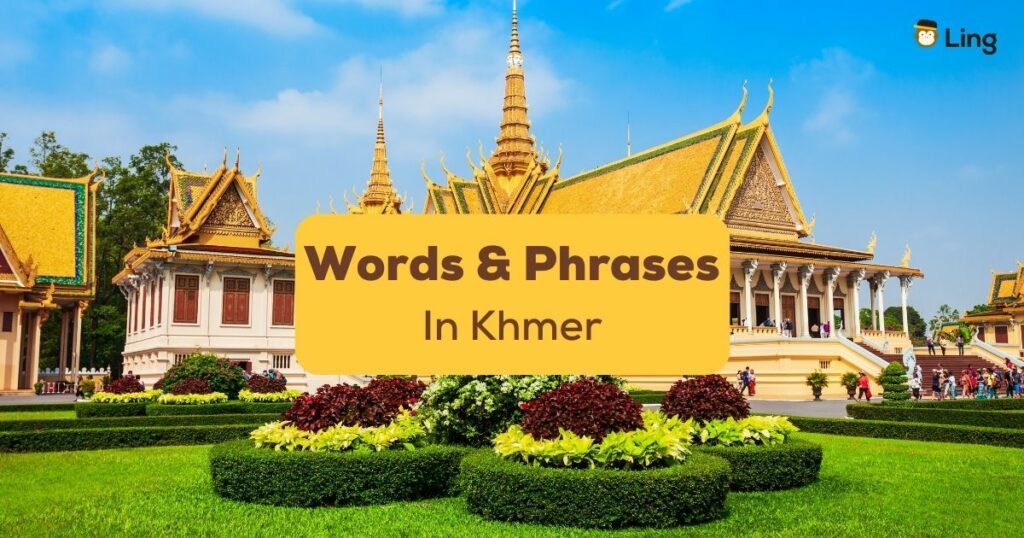It is a basic rule of politeness to say You’re Welcome in Khmer (Min Ei Te | មិនអីទេ) after receiving a Thank You (Or Kun | ឣរគុណ). Saying You’re Welcome is a way of showing that you acknowledged and appreciate the expression of gratitude by other people. For Cambodians, it is more than just politeness. Being able to reciprocate the expression of gratitude shows kindness and being there if the other person also needs your help.
If you want to learn how to say Thank you (Au Kun | ឣរគុណ) or Thank you very much in Khmer, Ling App has a separate blog for you. This app will also be helpful for you to learn other basic Khmer words and phrases, greetings like Hello (formal), Hello (informal), Goodbye (formal), Goodbye (informal), Good morning, and Good Afternoon. There’s a lot more to learn in the Khmer language if you want to speak Khmer like a pro. But, what exactly is the Khmer language?
How To Say You’re Welcome In Khmer Language
Now that you have learned a little bit about the Khmer language, let us talk about our main topic, which is saying You’re Welcome in Khmer.

If you are going on a trip to Cambodia, saying Thank, You is one of the first things you should know because it is essential. It will be used in different situations like asking for directions, dining in local Cambodian restaurants, riding a tuk-tuk, and more. But, what if you are the one who received Thank You from other people? How will you respond? Here’s a list of Khmer phrases that you’ll use
1. Min Ei Te (មិនអីទេ)
English Translation: You’re welcome.
If you are looking for an easy and basic way to say You’re Welcome in Khmer, you can use Mun Ay Te / Som Uñjaowñ (អត់អីទេ/សូមអញ្ជើញ). This can be used in almost all situations, like when the vendor/seller said thank you after you bought something from their shop when you ride a tuk-tuk, and after dining in a restaurant. So, if you are a beginner, this is the phrase to go.
You should also know that in Cambodia, they use Sampeah for greetings and saying Thank You.
2. Brakad Haeuy! (ប្រាកដហើយ!)
English Translation: Sure!
Do you want to keep it short? You can say, Brakad Haeuy! (ប្រាកដហើយ!). It means “Sure!” in English. This version of saying You’re Welcome in Khmer can be used for small favors and small talks. You can usually hear it in public transportations, local shops, and even in just passing by the streets. Yes, it may be short, but it has the same purpose.
3. Khmean Panhaha (គ្មានបញ្ហា)
English Translation: No problem.
Another way of saying You’re welcome in Khmer is Khmean Panhaha (គ្មានបញ្ហា ). Like in the English language, you can say you’re welcome in different ways. “No problem.” is one of them. Saying this will make the other people feel that what you have done for them is not a big deal for you.
4. Cham Khnhom Chuoy (ចាំខ្ញុំជួយ)
English Translation: You got it.
This way of saying You’re Welcome in Khmer is like saying that “You can expect me anytime you need help.” In our life, we all need that one person whom I know we can count on. That person who will have your back no matter what happens. So, when they say Thank You in Khmer, you can say, “Cham Khnhom Chuoy (ចាំខ្ញុំជួយ)”.
5. Kom Baram (កុំបារម្ភ)
English Translation: No Worries / Don’t Worry
If you want to make other people feel that they don’t have to worry about anything in return when they received your help, you can say “Kom Baram (កុំបារម្ភ).” Sometimes, people are conscious of receiving help from others because they are worried that it may have consequences or something in return. So, to ease that feeling to other people, you can say “Kom Baram (កុំបារម្ភ).”
6. Khnhom Rikreay Nueng Chuoy Neak (ខ្ញុំរីករាយនឹងជួយអ្នក)
English Translation: My pleasure.
Saying “Khnhom Rikreay Nueng Chuoy Neak (ខ្ញុំរីករាយនឹងជួយអ្នក)” is a different kind of saying you’re welcome in Khmer. Why? Because it means that what you have done to other people is really sincere and it also makes you feel good to help. Feeling the pleasure of helping someone out is another level. Offering help and feeling great about it is something only a genuine person can do. So, let someone know that you feel this way by saying, “Khnhom Rikreay Nueng Chuoy Neak (ខ្ញុំរីករាយនឹងជួយអ្នក)”.
7. Khnhom Sabay Chet Nueng Chuoy Neak (ខ្ញុំសប្បាយចិត្តនឹងជួយអ្នក)
English Translation: I’m happy to help.
Saying “Khnhom Sabay Chet Nueng Chuoy Neak (ខ្ញុំសប្បាយចិត្តនឹងជួយអ្នក)” is another beautiful way to say You’re Welcome to Khmer. If you are a traveler, you will really have to ask locals for different things like directions, menus, prices, and many more. What’s precious about the Cambodians is that they are always happy to help. You may also do that even if you are not a local by saying Khnhom Rikreay Nung Chuoy (ខ្ញុំរីករាយនឹងជួយ).
8. Khnhom Doeng Tha Neak Thveu Douch Knea Champoh Khnhom Dae (ខ្ញុំដឹងថាអ្នកធ្វើដូចគ្នាចំពោះខ្ញុំដែរ)
English Translation: I know you’ll do the same to me.
Lastly, you can also say Khnhom Doeng Tha Neak Thveu Douch Knea Champoh Khnhom Dae (ខ្ញុំដឹងថាអ្នកធ្វើដូចគ្នាចំពោះខ្ញុំដែរ) when you want to say You’re Welcome in Khmer differently and sincerely. Some articles say that saying “I know you’ll do the same to me.” is better than saying “You’re welcome” because, in this statement, you can see the attempt to build a stronger relationship. It deepens the thread that binds the two people together. It signifies trust and being always there for each other, which is definitely the main purpose of saying “You’re Welcome.”
Khmer: The Official Language Of Cambodia
To give you a short introduction, the Khmer language, also known as the Cambodian language, is the official language spoken in the country of Cambodia. If you have been to its neighboring countries like Vietnam, Laos, and Thailand, you might also find people who speak Khmer. You may also find their languages visually similar to Khmer because they have the same Pali and Sanskrit roots.
In the Khmer language, pronunciation is essential. For the spoken language, you have to learn the sound of each character and how the words are being pronounced to avoid confusion to the locals. If you want to learn more about the Khmer language, you can visit the blog Khmer Alphabet And Tips To Write In Khmer.
Although a large percentage of the Cambodian population knows how to speak English, it is still a must to learn at least basic Khmer words and phrases to express yourself and show respect to their culture.
Want To Learn Khmer Phrases Easily?
Cambodia is a wonderful country with a rich culture and traditions. No wonder why the travelers keep on coming back. Apart from the beautiful temples and tourist attractions, the people make travelers fall in love with Cambodia. So, if you want to make your whole trip meaningful, make sure to build connections with the locals. But, how can you do that if you don’t know how to speak their native language? The answer is pretty simple. Learn languages with Ling App.
Variety of lessons, interactive activities, audio recordings, blogs, name it! Ling App is a complete package for your language learning journey. If you are looking for a study buddy in learning Khmer, Ling App is the perfect choice for you. You can learn and have fun at the same time. You don’t need to worry about when and where you should learn because learning is at your own pace. No pressures, have fun learning languages.

Start your free language lessons now. You’ll never say sorry. You will not regret it. Learning Khmer and other languages can be easily achieved through Ling App. So, grab your phone or computer, thank Ling App later, and start learning Khmer now!


















